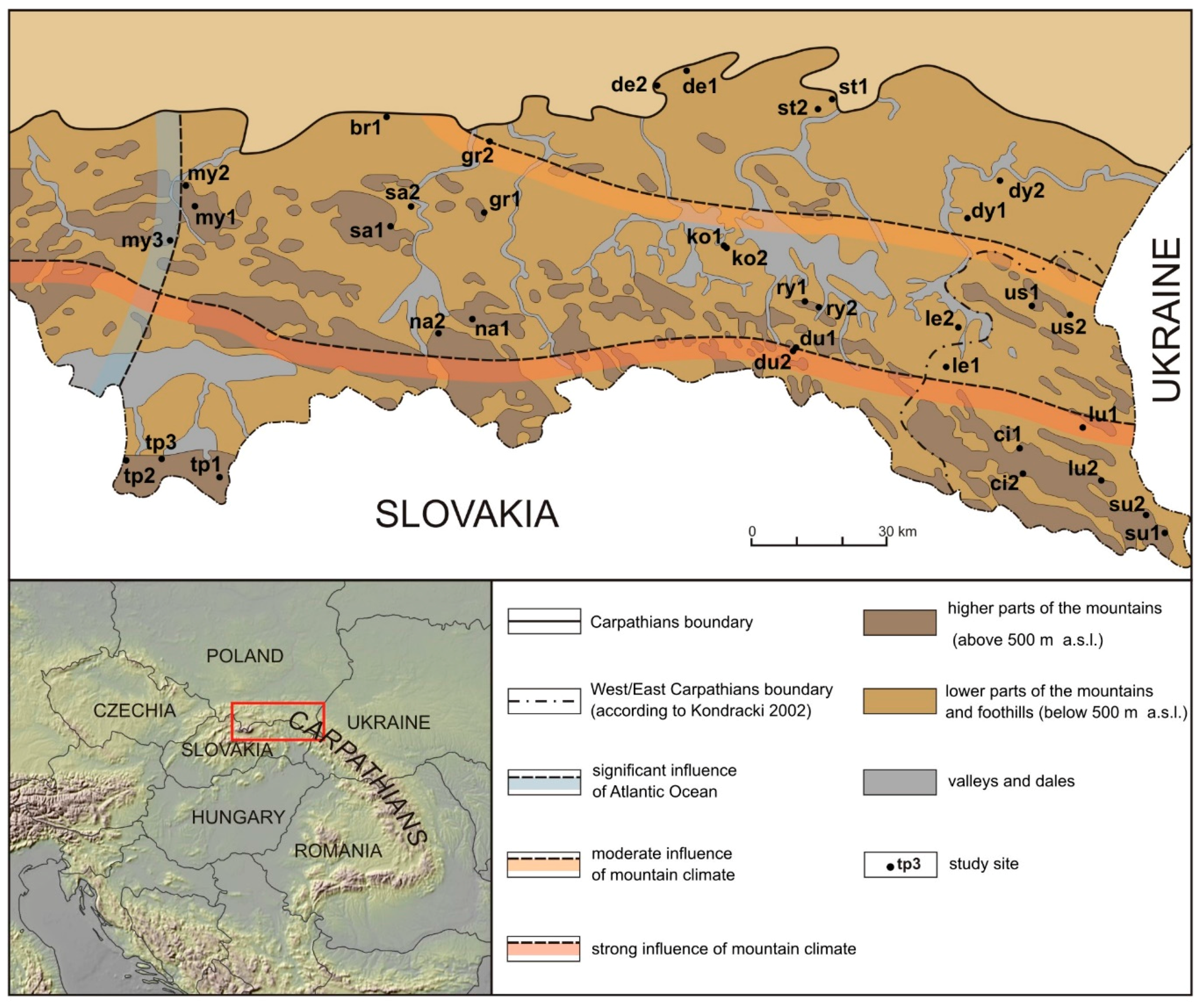Variability in Larch (Larix Decidua Mill.) Tree-Ring Growth Response to Climate in the Polish Carpathian Mountains
Abstract
:1. Introduction
2. Materials and Methods
2.1. Study Area Characteristics and Site Locations
2.2. Site Chronologies and Characteristics
2.3. Climate Data
2.4. Regional Patterns of Common Variation among Site Chronologies
2.5. Climate Influence on Tree-Ring Growth
3. Results
3.1. Chronologies Characteristics
3.2. Tree-Ring Growth and Its Spatial Variability, Influence of Altitude and Slope Aspect
3.3. Climate–Growth Relationship
4. Discussion
5. Conclusions
Acknowledgments
Author Contributions
Conflicts of Interest
References
- Lindner, M.; Maroschek, M.; Netherer, S.; Kremer, A.; Barbati, A.; Garcia-Gonzalo, J.; Seidl, R.; Delzon, S.; Corona, P.; Kolström, M.; et al. Climate change impacts, adaptive capacity, and vulnerability of European forest ecosystems. For. Ecol. Manag. 2010, 259, 698–709. [Google Scholar] [CrossRef]
- Thuiller, W.; Lavorel, S.; Araújo, M.B.; Sykes, M.T.; Prentice, I.C. Climate change threats to plant diversity in Europe. Proc. Natl. Acad. Sci. USA 2005, 102, 8245–8250. [Google Scholar] [CrossRef] [PubMed]
- Kienast, F.; Wildi, O.; Brzeziecki, B. Potential impacts of climate change on species richness in mountain forests—An ecological risk assessment. Biol. Conserv. 1998, 83, 291–305. [Google Scholar] [CrossRef]
- Beniston, M. Climatic change in mountain regions: A review of possible impacts. Clim. Chang. 2003, 59, 5–31. [Google Scholar] [CrossRef]
- Sidor, C.G.; Popa, I.; Vlad, R.; Cherubini, P. Different tree-ring responses of Norway spruce to air temperature across an altitudinal gradient in the Eastern Carpathians (Romania). Trees 2015, 29, 985–997. [Google Scholar] [CrossRef]
- Tessier, L.; Guibal, F.; Schweingruber, F.H. Research strategies in dendroecology and dendroclimatology in mountain environments. Clim. Chang. 1997, 36, 499–517. [Google Scholar] [CrossRef]
- Peterson, D.W.; Peterson, D.L.; Ettl, G.J. Growth responses of subalpine fir to climatic variability in the Pacific Northwest. Can. J. For. Res. 2002, 32, 1503–1517. [Google Scholar] [CrossRef]
- Krzysik, F. Nauka o Drewnie; Wyd. Naukowe PWN: Warszawa, Poland, 1978. [Google Scholar]
- Einspahr, D.W.; Wyckoff, G.W.; Fiscus, M.H. Larch—A Fast-Growing Fiber Source for the Lake States and Northeast. J. For. 1984, 82, 104–106. [Google Scholar]
- Karolewski, P.; Białobok, S. Wpływ dwutlenku siarki, ozonu, mieszaniny tych gazów i fluorowodoru na uszkodzenie igieł modrzewia europejskiego. Arbor. Kórnickie 1979, 24, 297–305. [Google Scholar]
- Feliksik, E. Studies on sensitivity of the more important forest trees to industrial pollution. Zesz. Naukowe AR Kraków Leśni. 1991, 254, 353–391. [Google Scholar]
- Boratyński, A. Systematyka i geograficzne. In Modrzewie Larix Mill; Białobok, S., Ed.; PWN: Warszawa; Poznań, Poland, 1986; pp. 63–108. [Google Scholar]
- Serre, F. The dendroclimatological value of the European larch (Larix decidua Mill.) in the French Maritime Alps. Tree-Ring Bull. 1978, 38, 25–34. [Google Scholar]
- Levanič, T. Vpliv klime na debelinsko rast macesna (Larix decidua Mill.) na zgornij gozdni meji v jv Alpahe. Zb. Gozd. Lesar. 2006, 78, 29–55. [Google Scholar]
- Rolland, C.; Petitcolas, V.; Michalet, R. Changes in radial tree growth for Picea abies, Larix decidua, Pinus cembra and Pinus uncinata near the alpine timberline since 1750. Trees 1998, 13, 40–53. [Google Scholar] [CrossRef]
- Carrer, M.; Urbinati, C. Long-term change in the sensitivity of tree-ring growth to climate forcing in Larix decidua. New Phytol. 2006, 170, 861–872. [Google Scholar] [CrossRef] [PubMed]
- Büntgen, U.; Frank, D.; Wilson, R.; Carrer, M.; Urbinati, C.; Esper, J. Testing for tree-ring divergence in the European Alps. Glob. Chang. Biol. 2008, 14, 2443–2453. [Google Scholar] [CrossRef]
- Büntgen, U.; Frank, D.; Neuenschwander, T.; Esper, J. Fading temperature sensitivity of Alpine tree growth at its Mediterranean margin and associated effects on large-scale climate reconstructions. Clim. Chang. 2012, 114, 651–666. [Google Scholar] [CrossRef]
- Carrer, M.; Urbinati, C. Age-dependent tree-ring growth responses to climate in Larix decidua and Pinus cembra. Ecology 2004, 85, 730–740. [Google Scholar] [CrossRef]
- Rolland, C. Decreasing teleconnections with inter-site distance in monthly climatic data and tree-ring width networks in a mountiainous Alpine area. Theor. Appl. Clim. 2002, 71, 63–75. [Google Scholar] [CrossRef]
- Frank, D.; Esper, J. Characterization and climate response patterns of a high-elevation, multi-species tree-ring network in the European Alps. Dendrochronologia 2005, 22, 107–121. [Google Scholar] [CrossRef]
- Serre-Bachet, F. Middle ages temperature reconstructions in Europe, a focus on northeastern Italy. Clim. Chang. 1994, 26, 213–224. [Google Scholar] [CrossRef]
- Büntgen, U.; Esper, J.; David, C.; Frank, D.C.; Nicolussi, K.; Schmidhalter, M. A 1052-year tree-ring proxy for Alpine summer temperatures. Clim. Dyn. 2005, 25, 141–153. [Google Scholar] [CrossRef]
- Daux, V.; Edouard, J.L.; Masson-Delmotte, V.; Stievenard, M.; Hoffmann, G.; Pierre, M.; Mestre, O.; Danis, P.A.; Guibal, F. Can climate variations be inferred from tree-ring parameters and stable isotopes from Larix decidua? Juvenile effects, budmoth outbreaks, and divergence issue. Earth Planet. Sci. Lett. 2011, 309, 221–233. [Google Scholar] [CrossRef]
- Büntgen, U.; Tegel, W.; Nicolussi, K.; McCormick, M.; Frank, D.; Trouet, V.; Kaplan, J.O.; Herzig, F.; Heussner, K.U.; Wanner, H.; et al. 2500 Years of European Climate Variability and Human Susceptibility. Science 2011, 331, 578–582. [Google Scholar] [CrossRef]
- Coppola, A.; Leonelli, G.; Salvatore, M.C.; Pelfini, M.; Baroni, C. Tree-ring-based summer mean temperature variations in the Adamello-Presanella Group (Italian Central Alps), 1610–2008 AD. Clim. Past 2013, 9, 211–221. [Google Scholar] [CrossRef]
- Danek, M.; Chuchro, M. Climate signal in tree rings of larch (Larix decidua Mill.) from the Karkonosze Mountains. In Proceedings of the 9th Conference Geoecological Problems of the Karkonose/Karkonosze Mountains: Past, present and future of transboundary cooperation in research and management, Szklarska Poręba, Poland, 12–14 October 2016. [Google Scholar]
- Feliksik, E. Wpływ warunków klimatycznych na wielkość przyrostów radialnych modrzewia europejskiego (Larix decidua Mill.) występującego w Karpatach. Sylwan 1992, 136, 61–67. [Google Scholar]
- Ermich, K. Zależność przyrostu drzew w tatrach od wahań klimatycznych. Acta Soc. Bot. Pol. 1955, 24, 245–273. [Google Scholar]
- Büntgen, U.; Frank, D.C.; Kaczka, R.J.; Verstege, A.; Zwijacz-Kozica, T.; Esper, J. Growth responses to climate in a multi-species tree-ring network in the Western Carpathian Tatra Mountains, Poland and Slovakia. Tree Physiol. 2007, 27, 689–702. [Google Scholar] [CrossRef] [PubMed]
- Feliksik, E.; Wilczyński, S. Wpływ temperatury i opadów na przyrost roczny drewna świerka, sosny i modrzewia występujących w Leśnictwie Pierściec u podnóża Pogórza Wilamowickiego. Probl. Zagospod. Ziem Górskich 1998, 44, 77–85. [Google Scholar]
- Feliksik, E.; Wilczyński, S. Wpływ warunków termicznych i pluwialnych na przyrost roczny modrzewi (Larix decidua Mill.). Sylwan 1998, 152, 85–90. [Google Scholar]
- Danek, M. Wpływ warunków klimatycznych na szerokość przyrostów rocznych modrzewia (Larix decidua Mill.) rosnącego w północnej części województwa małopolskiego. Sylwan 2009, 153, 768–776. [Google Scholar]
- Danek, M.; Danek, T. Example of using alternative methods of data processing in dendroclimatological analysis of larch (Larix decidua Mill.) from southern Poland. Sylwan 2011, 155, 147–158. [Google Scholar]
- Danek, M.; Chuchro, M. Sygnał dendroklimatyczny w sekwencjach przyrostów rocznych modrzewia rosnącego we wschodniej części polskich Karpat. Stud. Mater. CEPL Rogowie 2016, 47, 35–42. [Google Scholar]
- Kondracki, J. Geografia Regionalna Polski; Wyd. Naukowe PWN: Warszawa, Poland, 2009. [Google Scholar]
- Okołowicz, W.; Martyn, D. Regiony klimatyczne. In Atlas Geograficzny Polski; Górski, H., Melnicka, P., Eds.; PPWK: Warszawa, Poland, 1984; p. 11. [Google Scholar]
- Matuszkiewicz, J.M. Geobotanical Regionalization of Poland (Regionalizacja Geobotaniczna Polski); IGiPZ PAN: Warszawa, Polska, 2008; Available online: http://www.igipz.pan.pl/Regiony-geobotaniczne-zgik.html (accessed on 2 March 2017).
- Kondracki, J. Karpaty; Wyd. Szkolne i Pedagogiczne: Warszawa, Poland, 1978; p. 273. [Google Scholar]
- Warszyńska, J. Karpaty Polskie. Przyroda, Człowiek, Działalność; Wyd. UJ: Kraków, Polska, 1996; p. 367. [Google Scholar]
- Izmiłow, B.; Kaszowski, L.; Krzemień, K.; Święchowicz, J. Rzeźba. In Karpaty Polskie: Przyroda, Człowiek, Działalność; Warszyńska, J., Ed.; Wyd. UJ: Kraków, Poland, 1996; p. 367. [Google Scholar]
- Matuszkiewicz, W. Fitosocjologiczne Podstawy Typologii Lasów Polski. Prace Inst. Badaw. Leśn. 1978, 558, 3–39. [Google Scholar]
- Walanus, A. Program Quercus; Instrukcja Obsługi; AGH-UST: Kraków, Poland, 2005. [Google Scholar]
- Holmes, R.L. User Manual for Program COFECHA; Laboratory of Tree-Ring Research, University of Arizona: Tucson, AZ, USA, 1999. [Google Scholar]
- Cook, E.R.; Holmes, R.L. User Manual for Program ARSTAN; Laboratory of Tree-Ring Research, University of Arizona: Tucson, AZ, USA, 1999. [Google Scholar]
- Cook, E.R.; Peters, K. Calculating unbiased tree-ring indices for the study of climatic and environmental change. Holocene 1997, 361–370. [Google Scholar] [CrossRef]
- Cook, E.R.; Peters, K. The smoothing spline: A new approach to standardizing forest interior tree-ring width series for dendroclimatic studies. Tree-Ring Bull. 1981, 41, 45–53. [Google Scholar]
- Cook, E.R. A Time Series Analysis Approach to Tree-Ring Standardization. Ph.D. Thesis, University of Arizona, Tucson, AZ, USA, 1985; p. 171. [Google Scholar]
- Holmes, R.L.; Adams, R.K.; Fritts, H.C. Tree-Ring Chronologies of Western North America: California, Eastern Oregon and Northern Great Basin with Procedures Used in the Chronology Development Work Including Users Manuals for the COFECHA and ARSTAN Computer Programs; Chronology Series VI; Laboratory of Tree-Ring Research, University of Arizona: Tucson, AZ, USA, 1986; p. 182. [Google Scholar]
- Fritts, H. Tree Rings and Climate; Academic Press: London, UK, 1976; p. 567. ISBN 978-0-12-268450-0. [Google Scholar]
- Savva, Y.; Oleksyn, J.; Reich, P.B.; Tjoelker, M.G.; Vaganov, E.A.; Modrzynski, J. Interannual growth response of Norway spruce to climate along an altitudinal gradient in the Tatra Mountains, Poland. Trees 2006, 20, 735–746. [Google Scholar] [CrossRef]
- Cook, E.R.; Kariukstis, L.A. Methods of Dendrochronology: Applications in the Environmental Sciences; Springer Science + Business Media: New York, NY, USA, 1990; p. 288. ISBN 978-90-481-4060-2. [Google Scholar]
- Wigley, T.M.L.; Briffa, K.R.; Jones, P.D. On the average value of correlated time series, with applications in dendroclimatology and hydrometeorology. J. Clim. Appl. Meteorol. 1984, 23, 201–213. [Google Scholar] [CrossRef]
- Mitchell, T.; Carter, T.R.; Jones, P.; Hulme, M. A comprehensive set of high-resolution grids of monthly climate for Europe and the globe: The observed record (1901–2000) and 16 scenarios (2001–2100). Tyndall Cent. Work. Pap. 2004, 55, 25. [Google Scholar]
- Carrer, M.; Nola, P.; Eduard, J.L.; Motta, R.; Urbinati, C. Regional variability of climate–growth relationships in Pinus cembra high elevation forests in the Alps. J. Ecol. 2007, 95, 1072–1083. [Google Scholar] [CrossRef]
- Chuchro, M.; Danek, M. Applicability of gridded climate data in tree-ring studies of larch from southern part of Poland. In Proceedings of the SGEM 2017: Water Resorces, Forest Ecosystem SGEM, Vienna, Austria, 27–30 November 2017; pp. 717–726. [Google Scholar]
- Jolliffe, I.T. Principal Component Analysis, 2nd ed.; Springer Series in Statistics; Springer: New York, NY, USA, 2002; ISBN 0-387-95442-2. [Google Scholar]
- Richman, M.B. Rotation of principal components. J. Climatol. 1986, 6, 293–335. [Google Scholar] [CrossRef]
- Biondi, F.; Waikul, K. DENDROCLIM 2002: A C++ program for statistical calibration of climate signals in tree-ring chronologies. Comput. Geosci. 2004, 30, 303–311. [Google Scholar] [CrossRef]
- LeBlanc, D.C.; Stahle, D.W. Radial growth responces of four oak species to climate in eastern and central North America. Can. J. For. Res. 2015, 45, 793–804. [Google Scholar] [CrossRef]
- Grissino-Mayer, H.D. Evaluating crossdating accuracy: A manual and tutorial for the computer program COFECHA. Tree Ring Res. 2001, 57, 205–221. [Google Scholar]
- Moser, L.; Fonti, P.; Büntgen, U.; Esper, J.; Luterbacher, J.; Franzen, J.; Frank, D. Timing and duration of European larch growing season along altitudinal gradients in the Swiss Alps. Tree Physiol. 2009, 30, 225–233. [Google Scholar] [CrossRef] [PubMed]
- Oribe, Y.; Kubo, T. Effect of heat on cambial reactivation during winter dormancy in evergreen and deciduous conifers. Tree Physiol. 1997, 17, 81–87. [Google Scholar] [CrossRef] [PubMed]
- Gričar, J.; Zupančič, M.; Čufar, K.; Koch, G.; Schmitt, U.; Oven, P. Effect of local heating and cooling on cambial activity and cell differentiation in the stem of Norway spruce (Picea abies). Ann. Bot. 2006, 97, 943–951. [Google Scholar] [CrossRef]
- Leal, S.; Melvin, T.M.; Grabner, M.; Wimmer, R.; Briffa, K.R. Tree ring-growth variability in the Austrian Alps: The influence of site, altitude, tree species and climate. Boreas 2007, 36, 426–440. [Google Scholar] [CrossRef]
- Koprowski, M. Long-term increase of March temperature has no negative impact on tree rings of European larch (Larix decidua) in lowland Poland. Trees 2012, 26, 1895–1903. [Google Scholar] [CrossRef]
- Vitas, A. A dendroclimatological Analysis of European Larch (Larix decidua Mill.) from Lithuania. Balt. For. 2015, 20, 65–72. [Google Scholar]
- Chuchro, M.; Danek, M. Intra-site variation in tree rings of larch (Larix Decidua Mill.) from polish carpathian mountains. In Proceedings of the SGEM 2017: Water Resorces, Forest Ecosystem SGEM, Vienna, Austria, 27–30 November 2017; pp. 877–884. [Google Scholar]
- Chałupka, W.; Kosiński, G. Fizjologia wzrostu i rozwoju. In Modrzewie Larix Mill.; Białobok, S., Ed.; PWN: Warsaw; Poznan, Poland, 1986; pp. 173–213. [Google Scholar]
- Woś, A. Klimat Polski; Wyd. Naukowe PWN: Warszawa, Poland, 1999. [Google Scholar]
- Oleksyn, J.; Fritts, H. Influence of climatic factors upon tree rings of Larix decidua and L. decidua × L. kaempferi from Puławy, Poland. Trees-Struct. Funct. 1991, 5, 75–82. [Google Scholar] [CrossRef]
- Grudd, H.; Briffa, K.R.; Karlén, W.; Bartholin, T.S.; Jones, P.D.; Kromer, B. A 7400-year tree-ring chronology in northern Swedish Lapland: Natural climatic variability expressed on annual to millennial timescales. Holocene 2002, 12, 657–665. [Google Scholar] [CrossRef]
- Simak, M. Photo- and thermoperiodic responses of different larch provenances (Larix decidua Mill.). Stud. For. Suec. 1970, 86, 1–31. [Google Scholar]
- Oberhuber, W. Influence of climate on radial growth of Pinus cembra within the alpine timberline ecotone. Tree Physiol. 2004, 24, 291–301. [Google Scholar] [CrossRef] [PubMed]
- Anfodillo, T.; Rento, S.; Carraro, V.; Furlanetto, L.; Urbinati, C.; Carrer, M. Tree water relations and climatic variations at the alpine timberline: Seasonal changes of sap flux and xylem water potential in Larix decidua Miller, Pisea abies (L.) Krast and Pinus cembra L. Ann. For. Sci. 1998, 55, 159–172. [Google Scholar] [CrossRef]
- Wilczyński, S.; Szymański, N.; Wertz, B.; Muter, E. Wpływ wieku na odpowiedź przyrostową drzew na czynnik klimatyczny na przykładzie modrzewia europejskiego. Stud. Mater. CEPL Rogowie 2014, 16, 256–264. [Google Scholar]
- Schweingruber, F.H. Tree Rings and Environment-Dendroecology; Paul Haupt Publishers: Berne, Switzerland, 1996; p. 609. ISBN 3-258-05458-4. [Google Scholar]
- Carrer, M. Individualistic and Time-Varying Tree-Ring Growth to Climate Sensitivity. PLoS ONE 2011, 6, 1–8. [Google Scholar] [CrossRef] [PubMed]
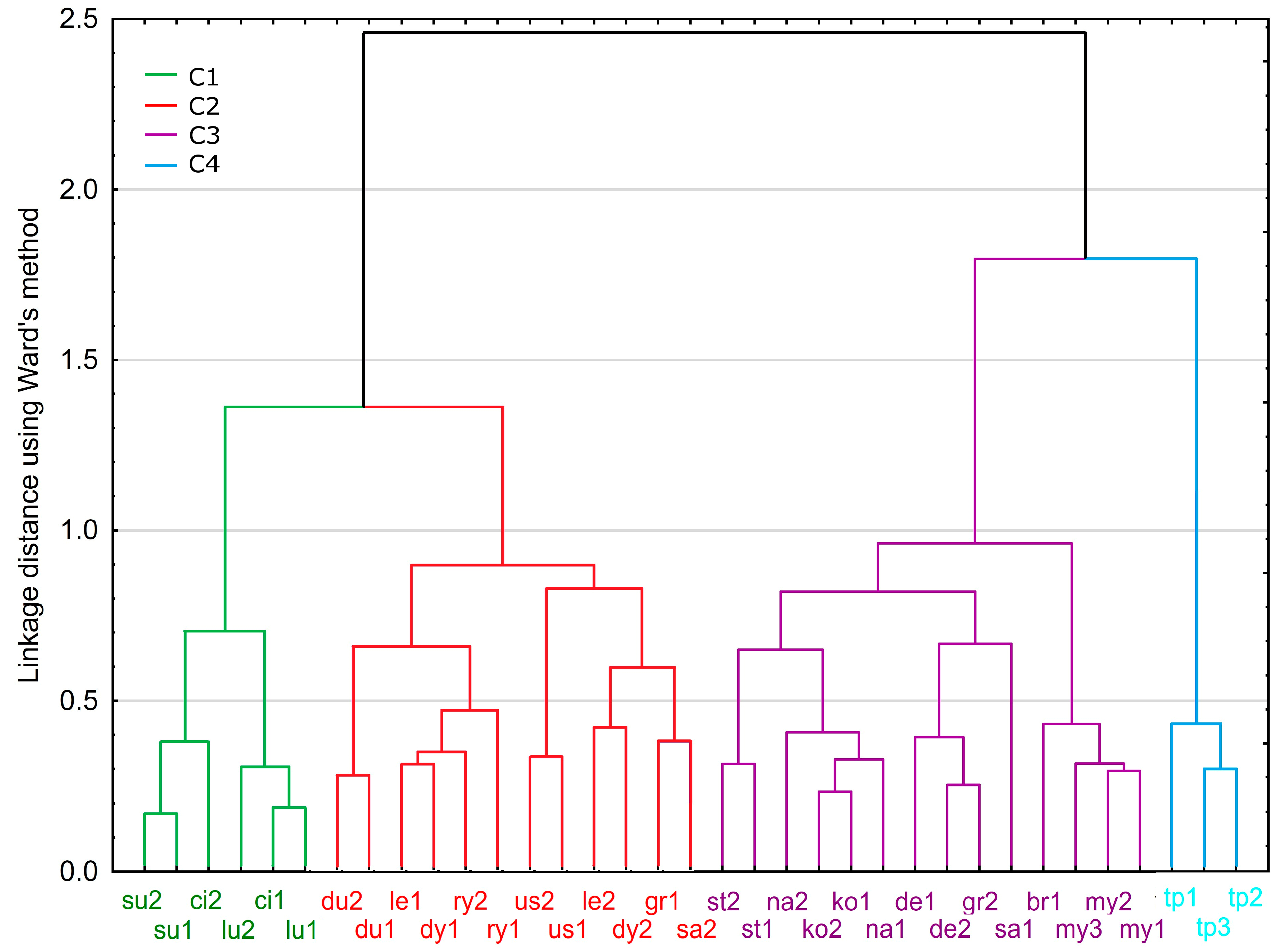
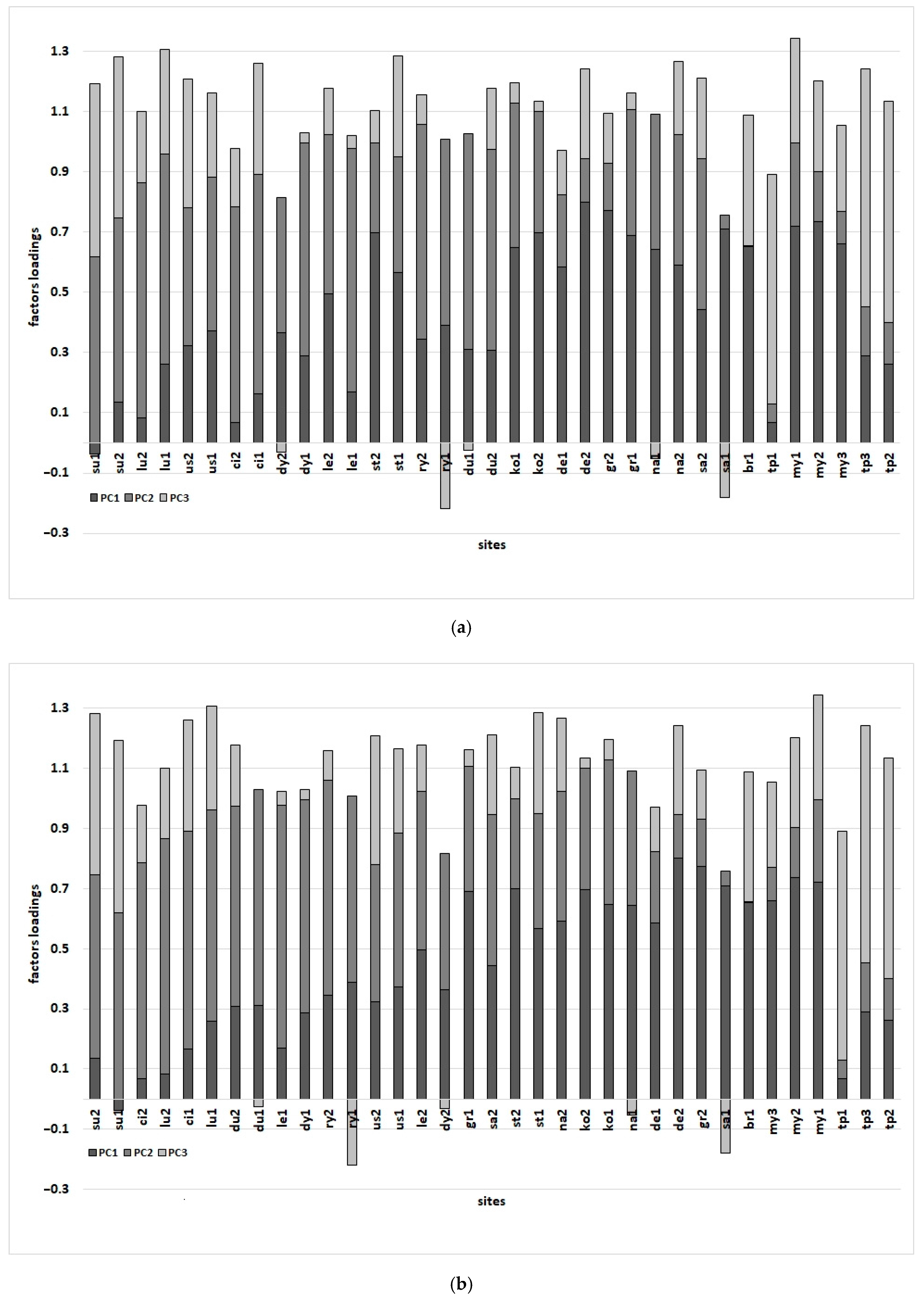

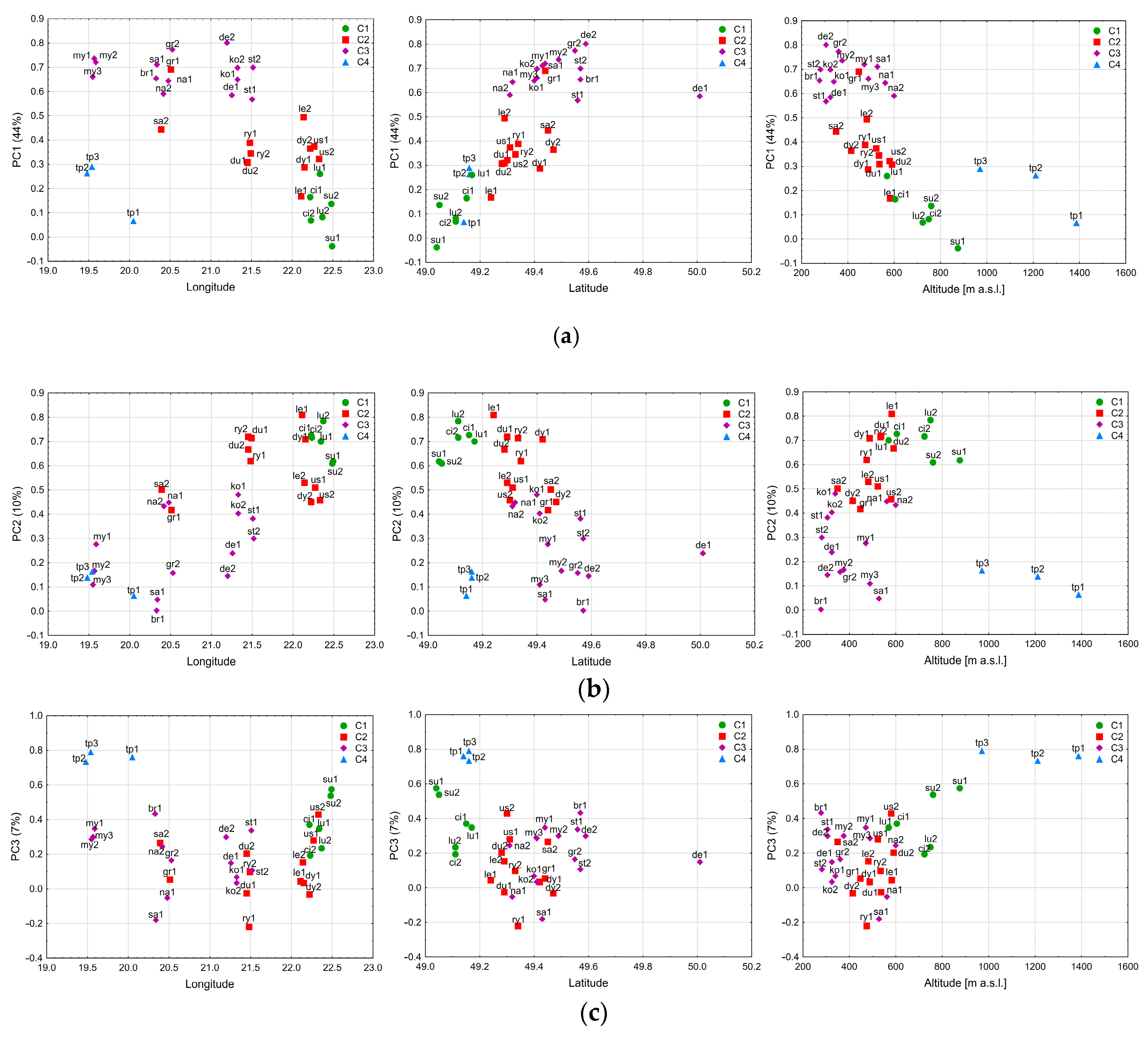
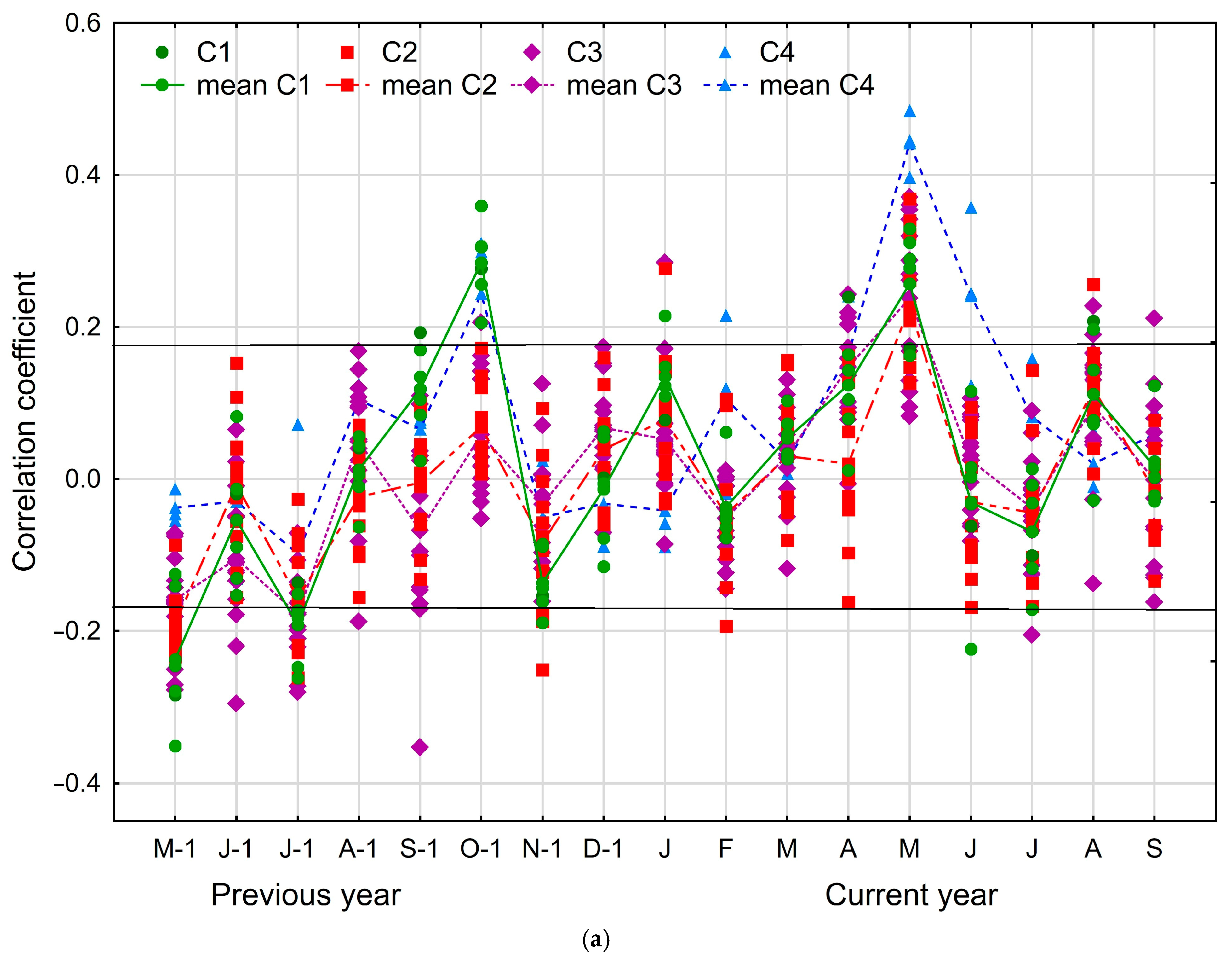
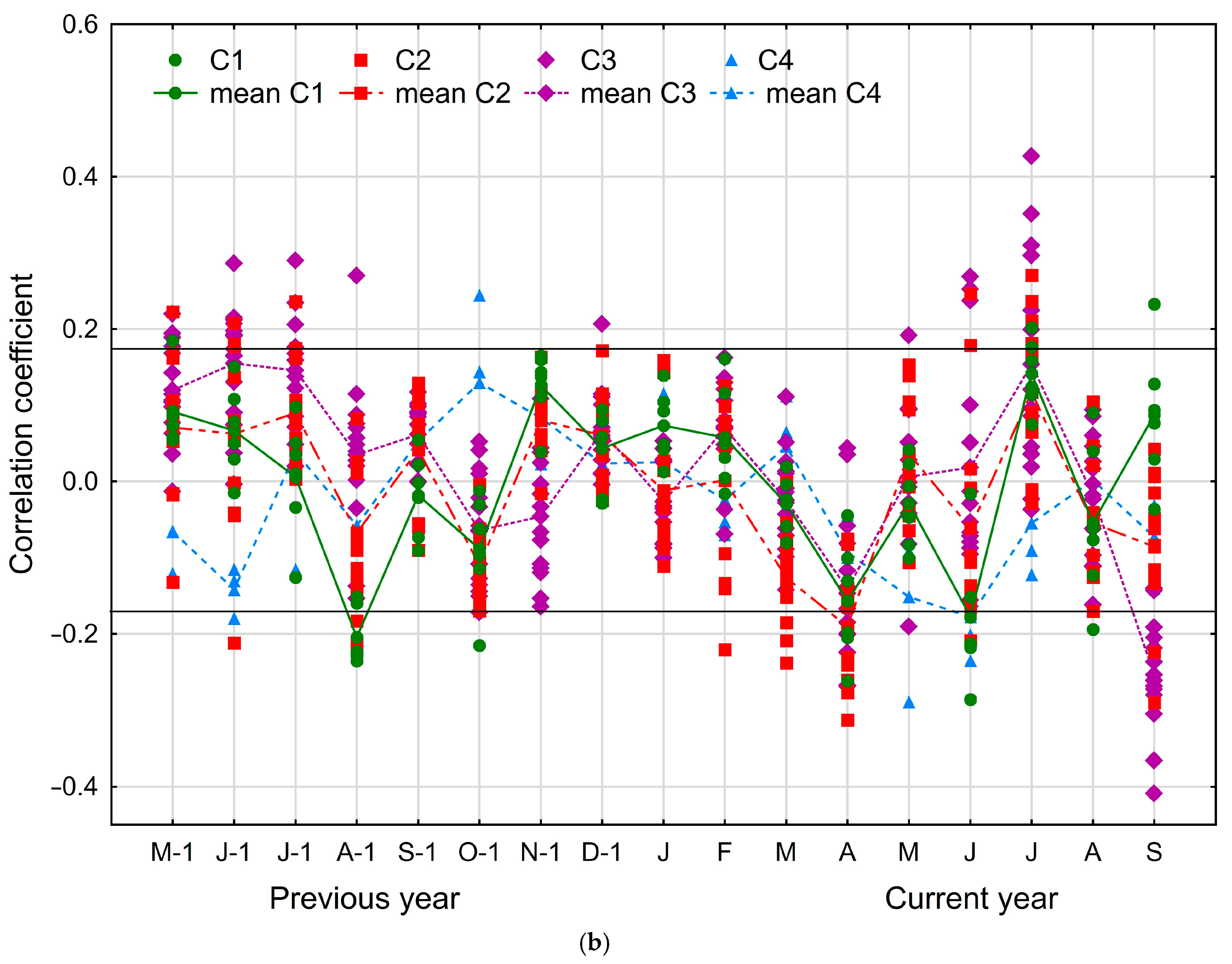
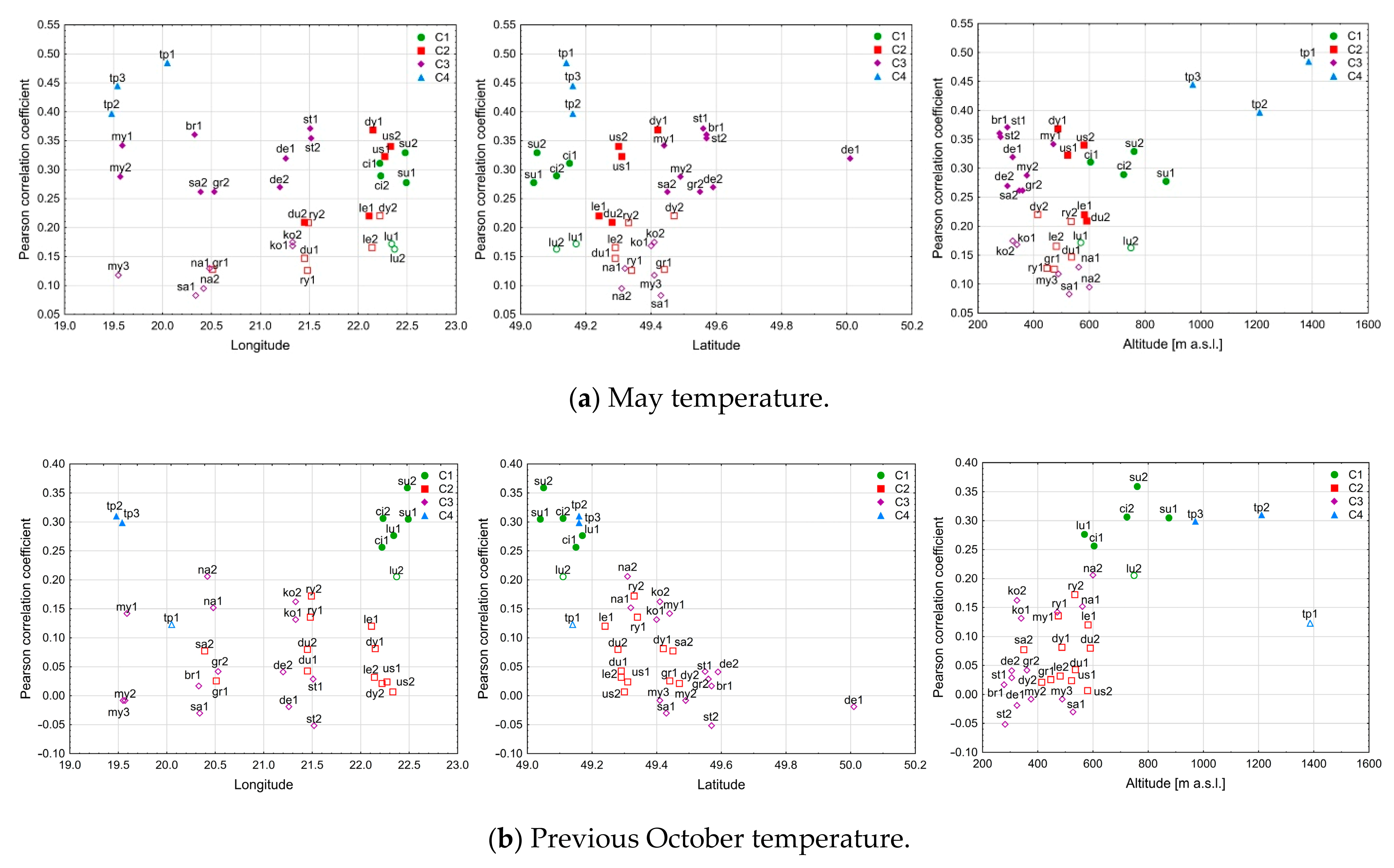
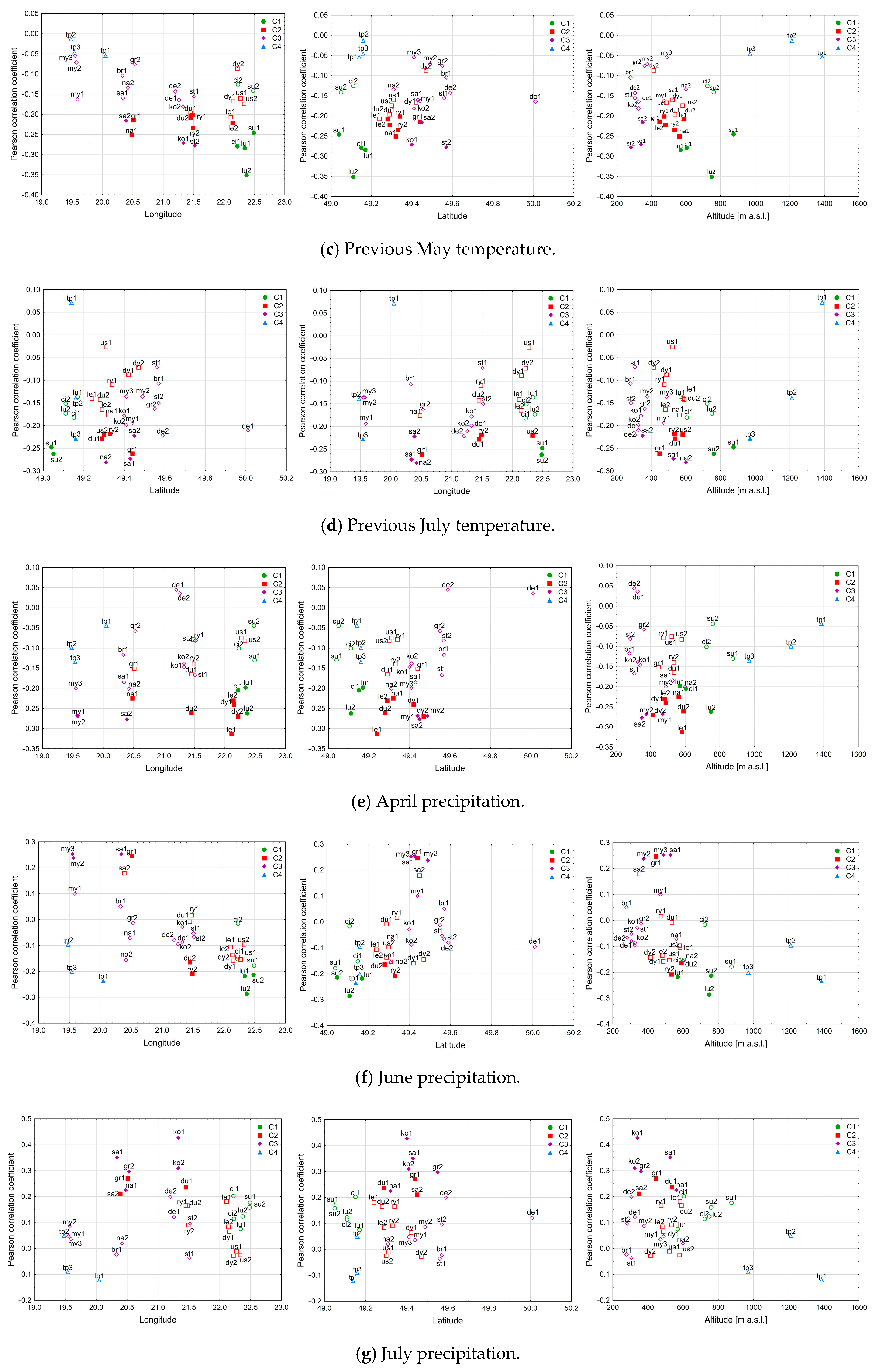

| No. | Site | Longitude | Latitude | Altitude (m a.s.l.) | Slope Aspect | Forest Type | Soil Type | No. of Trees |
|---|---|---|---|---|---|---|---|---|
| 1 | tp1 | 20°5′1.90″ E | 49°14′17.00″ N | 1387 | SE | MFF | cambisols | 16 |
| 2 | tp2 | 19°48′6.20″ E | 49°16′2.90″ N | 1211 | NE | MFF | cambisols | 20 |
| 3 | tp3 | 19°54′31.00″ E | 49°16′36.80″ N | 971 | N | MFF | cambisols | 20 |
| 4 | my1 | 19°59′34.32″ E | 49°44′59.59″ N | 471 | WWS | MFF | cambisols | 17 |
| 5 | my2 | 19°57′30.38″ E | 49°49′12.45″ N | 376 | NNW | MFF | cambisols | 14 |
| 6 | my3 | 19°55′26.74″ E | 49°41′0.50″ N | 489 | S | MFF | cambisols | 13 |
| 7 | br1 | 20°33′13.54″ E | 49°57′50.60″ N | 278 | N | USFF | cambisols | 17 |
| 8 | sa1 | 20°34′11.17″ E | 49°43′2.14″ N | 528 | N | MFF | cambisols | 11 |
| 9 | sa2 | 20°39′31.23″ E | 49°45′59.33″ N | 349 | SSE | UFF | cambisols | 14 |
| 10 | na1 | 20°48′53.20″ E | 49°32′35.90″ N | 562 | SW | MFF | cambisols | 15 |
| 11 | na2 | 20°42′43.50″ E | 49°31′40.70″ N | 600 | NE | MFF | cambisols | 13 |
| 12 | gr1 | 20°51′45.10″ E | 49°44′40.10″ N | 447 | NE | UFF | cambisols | 13 |
| 13 | gr2 | 20°53′46.30″ E | 49°55′48.70″ N | 361 | E | UFF | cambisols | 14 |
| 14 | de1 | 21°26′36.20″ E | 50°1′29.83″ N | 325 | N | UFF | luvisols | 14 |
| 15 | de2 | 21°20′51.46″ E | 49°59′56.94″ N | 306 | W | UFF | luvisols | 14 |
| 16 | ko1 | 21°33′22.68″ E | 49°40′47.77″ N | 340 | SW | UFF | cambisols | 20 |
| 17 | ko2 | 21°33′16.10″ E | 49°41′12.02″ N | 325 | NE | UFF | cambisols | 20 |
| 18 | st1 | 21°51′37.57″ E | 49°56′39.57″ N | 306 | WSW | UFF | cambisols | 15 |
| 19 | st2 | 21°52′55.23″ E | 49°57′52.84″ N | 282 | NNE | UFF | cambisols | 15 |
| 20 | ry1 | 21°48′33.12″ E | 49°34′18.90″ N | 474 | S-SE | MFF | cambisols | 17 |
| 21 | ry2 | 21°49′36.64″ E | 49°33′19.12″ N | 534 | N | MFF | cambisols | 15 |
| 22 | du1 | 21°45′34.52″ E | 49°29′9.77″ N | 536 | NW | MFF | cambisols | 20 |
| 23 | du2 | 21°45′21.46″ E | 49°28′44.65″ N | 590 | SSE | MFF | cambisols | 20 |
| 24 | dy1 | 22°15′3.50″ E | 49°42′37.00″ N | 487 | WNW | UFF | cambisols | 20 |
| 25 | dy2 | 22°22′21.80″ E | 49°47′7.40″ N | 414 | SW-SSW | UFF | cambisols | 20 |
| 26 | us1 | 22°27′3.09″ E | 49°31′27.80″ N | 522 | S | MFF | cambisols | 16 |
| 27 | us2 | 22°33′47.08″ E | 49°30′27.61″ N | 580 | N | MFF | cambisols | 17 |
| 28 | le1 | 22°11′48.80″ E | 49°24′45.60″ N | 582 | NE | MFF | cambisols | 24 |
| 29 | le2 | 22°14′4.70″ E | 49°29′4.20″ N | 481 | NW-SW | UFF | cambisols | 20 |
| 30 | lu1 | 22°34′33.10″ E | 49°17′5.80″ N | 569 | NW | MFF | cambisols | 20 |
| 31 | lu2 | 22°37′50.00″ E | 49°11′32.00″ N | 749 | N | MFF | cambisols | 20 |
| 32 | ci1 | 22°22′51.70″ E | 49°15′5.10″ N | 604 | NNE | MFF | cambisols | 20 |
| 33 | ci2 | 22°23′56.60″ E | 49°11′58.60″ N | 723 | SE | MFF | cambisols | 19 |
| 34 | su1 | 22°49′6.30″ E | 49°4′15.80″ N | 875 | SW | MFF | cambisols | 20 |
| 35 | su2 | 22°48′57.50″ E | 49°5′39.90″ N | 760 | WNW | MFF | cambisols | 21 |
| No. | Site Code | Cluster | Full Period Covered | Number of Years | No. of Trees in Chronology | MSL | AGR (mm) | AC | MS | mRbar (30_15) | mEPS (30_15) |
|---|---|---|---|---|---|---|---|---|---|---|---|
| 1 | tp1 | C4 | 1743–2015 | 274 | 14 | 225 | 0.620 | 0.76 | 0.25 | 0.55 | 0.96 |
| 2 | tp2 | C4 | 1869–2015 | 147 | 18 | 133 | 1.295 | 0.79 | 0.25 | 0.70 | 0.97 |
| 3 | tp3 | C4 | 1868–2015 | 148 | 17 | 136 | 1.542 | 0.79 | 0.20 | 0.68 | 0.97 |
| 4 | my1 | C3 | 1873–2008 | 136 | 12 | 131 | 1.834 | 0.76 | 0.23 | 0.56 | 0.93 |
| 5 | my2 | C3 | 1874–2009 | 136 | 11 | 127 | 1.646 | 0.62 | 0.25 | 0.59 | 0.92 |
| 6 | my3 | C3 | 1866–2009 | 144 | 11 | 139 | 1.717 | 0.77 | 0.25 | 0.59 | 0.94 |
| 7 | br1 | C3 | 1871–2008 | 138 | 12 | 129 | 1.829 | 0.73 | 0.26 | 0.54 | 0.92 |
| 8 | sa1 | C3 | 1900–2009 | 110 | 10 | 101 | 1.964 | 0.68 | 0.25 | 0.50 | 0.9 |
| 9 | sa2 | C2 | 1916–2009 | 94 | 10 | 89 | 2.568 | 0.74 | 0.23 | 0.47 | 0.9 |
| 10 | na1 | C3 | 1895–2010 | 116 | 14 | 99 | 2.795 | 0.63 | 0.23 | 0.45 | 0.91 |
| 11 | na2 | C3 | 1896–2010 | 115 | 13 | 112 | 2.015 | 0.79 | 0.23 | 0.58 | 0.95 |
| 12 | gr1 | C2 | 1894–2010 | 117 | 12 | 110 | 1.904 | 0.81 | 0.21 | 0.47 | 0.91 |
| 13 | gr2 | C3 | 1889-2010 | 122 | 13 | 119 | 1.625 | 0.63 | 0.26 | 0.49 | 0.92 |
| 14 | de1 | C3 | 1911–2008 | 98 | 11 | 93 | 2.534 | 0.65 | 0.26 | 0.45 | 0.88 |
| 15 | de2 | C3 | 1898–2008 | 112 | 11 | 105 | 1.964 | 0.77 | 0.23 | 0.40 | 0.87 |
| 16 | ko1 | C3 | 1888–2014 | 127 | 16 | 118 | 1.760 | 0.69 | 0.25 | 0.52 | 0.94 |
| 17 | ko2 | C3 | 1895–2014 | 120 | 19 | 112 | 1.960 | 0.65 | 0.25 | 0.52 | 0.95 |
| 18 | st1 | C3 | 1879–2013 | 135 | 15 | 130 | 1.549 | 0.78 | 0.21 | 0.55 | 0.95 |
| 19 | st2 | C3 | 1894–2013 | 120 | 15 | 110 | 2.012 | 0.70 | 0.20 | 0.54 | 0.94 |
| 20 | ry1 | C2 | 1901–2013 | 113 | 16 | 107 | 1.601 | 0.69 | 0.21 | 0.47 | 0.92 |
| 21 | ry2 | C2 | 1898–2013 | 116 | 13 | 110 | 1.679 | 0.68 | 0.23 | 0.55 | 0.94 |
| 22 | du1 | C2 | 1907-2014 | 108 | 17 | 102 | 1.981 | 0.80 | 0.21 | 0.45 | 0.93 |
| 23 | du2 | C2 | 1897–2014 | 118 | 19 | 111 | 1.651 | 0.83 | 0.19 | 0.43 | 0.93 |
| 24 | dy1 | C2 | 1908–2015 | 108 | 18 | 99 | 1.858 | 0.73 | 0.19 | 0.50 | 0.94 |
| 25 | dy2 | C2 | 1906–2015 | 110 | 13 | 104 | 1.465 | 0.78 | 0.17 | 0.51 | 0.93 |
| 26 | us1 | C2 | 1893–2014 | 122 | 15 | 116 | 1.898 | 0.69 | 0.21 | 0.48 | 0.91 |
| 27 | us2 | C2 | 1898–2014 | 117 | 14 | 111 | 2.573 | 0.64 | 0.22 | 0.58 | 0.94 |
| 28 | le1 | C2 | 1907–2015 | 109 | 19 | 102 | 1.932 | 0.76 | 0.19 | 0.57 | 0.96 |
| 29 | le2 | C2 | 1887–2015 | 129 | 18 | 110 | 1.466 | 0.75 | 0.19 | 0.47 | 0.94 |
| 30 | lu1 | C1 | 1911–2014 | 104 | 17 | 97 | 2.784 | 0.67 | 0.22 | 0.49 | 0.94 |
| 31 | lu2 | C1 | 1900–2014 | 115 | 18 | 111 | 2.233 | 0.88 | 0.23 | 0.57 | 0.96 |
| 32 | ci1 | C1 | 1905–2014 | 110 | 17 | 105 | 2.600 | 0.72 | 0.20 | 0.53 | 0.95 |
| 33 | ci2 | C1 | 1916–2014 | 99 | 18 | 94 | 2.287 | 0.74 | 0.20 | 0.48 | 0.94 |
| 34 | su1 | C1 | 1918–2014 | 97 | 17 | 92 | 1.919 | 0.79 | 0.21 | 0.56 | 0.95 |
| 35 | su2 | C1 | 1912–2014 | 103 | 19 | 92 | 2.292 | 0.67 | 0.25 | 0.54 | 0.96 |
© 2017 by the authors. Licensee MDPI, Basel, Switzerland. This article is an open access article distributed under the terms and conditions of the Creative Commons Attribution (CC BY) license (http://creativecommons.org/licenses/by/4.0/).
Share and Cite
Danek, M.; Chuchro, M.; Walanus, A. Variability in Larch (Larix Decidua Mill.) Tree-Ring Growth Response to Climate in the Polish Carpathian Mountains. Forests 2017, 8, 354. https://doi.org/10.3390/f8100354
Danek M, Chuchro M, Walanus A. Variability in Larch (Larix Decidua Mill.) Tree-Ring Growth Response to Climate in the Polish Carpathian Mountains. Forests. 2017; 8(10):354. https://doi.org/10.3390/f8100354
Chicago/Turabian StyleDanek, Małgorzata, Monika Chuchro, and Adam Walanus. 2017. "Variability in Larch (Larix Decidua Mill.) Tree-Ring Growth Response to Climate in the Polish Carpathian Mountains" Forests 8, no. 10: 354. https://doi.org/10.3390/f8100354




